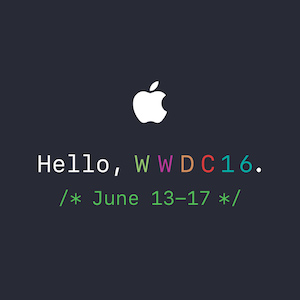WWDC 2016 is less than one week away. I’ve only been to the actual conference once, and that was the 2014 instance. I had such a great time, met people that I continue to stay in contact with despite not having seen them since, and learned so much. That was the WWDC where Swift was unveiled to the world. With such a huge announcement as introducing a new programming language, I think it’s a WWDC that will stand the test of time. In a lot of ways, WWDC is like the one time of year that we developers get a new delivery of gifts from Apple. Gifts that we can use to create new business ventures, deliver new delightful features to our customers, and even gifts that will make our own lives easier- both as developers within Apple’s platform, as well as end users of many apps ourselves. I have no shortage of things that I’d like to see from Apple, both from a developer perspective, as well as an end user perspective. Here’s my WWDC 2016 wish list:
I tried to keep this list in the realm of possibility, and it is ordered by a mild amount of prioritization.
- Xcode Swift Support. Yes, you can build Swift apps in Xcode, and I do. And yes, there have been improvements in this area. There are just some fundamental things broken with building Swift apps in Xcode. For example, I hope I never have to see that “Xcode can only refactor C and Objective-C code.” dialog again.
Frankly, I would be embarrassed if I had to put an error message in one of my apps to the tune of, “sorry, you tried to do something legitimate that we just don’t support.” And then to think that this message has been around for going on two years!?!?! Additionally, while less frequent as a year ago, I still get SourceKit crashes in Xcode. That’s when all of a sudden syntax highlighting of your source code stops, and there is no autocompletion. It’s usually paired with an error message. And often, there’s no suggested course to correct whatever you did to crash SourceKit. It’s usually the case that you typed in some non-compilable Swift that rather than getting a nice error message, your IDE stops working. Do you think a third-party IDE would survive with shortcomings like this? I don’t.
-
Automated Test Support. Reflecting over the past five or so years of WWDC, it’s been amazing to watch the progress Apple has made in supporting automated testing of iOS apps. I remember when first joining the iOS dev community, being astounded by how little Apple made available for automated testing (compared to the Java world that I came from). Fast forward to today, and it’s a fairly comprehensive suite of tools for testing your apps. A couple gaps that I would like filled include:
- Faster test execution – I heard that Visual Studio, the .NET IDE, actually will run your test bed anytime you save a source file in your project. That sounds AMAZING! In order for that to be possible, test execution must be fast. Right now, just to run a suite of a couple hundred XCTest unit tests, it’s about 20 seconds. That needs to be sped up.
- Headless test runners – Right now, running tests (unit or otherwise), require a simulator or device to fire up your app, and run through the tests. This shouldn’t be needed. It would be so nice to run tests without the overhead of the iOS simulator or device.
-
Continuous Integration Improvements – Xcode Server is a start, but so far from being something that would stand our as a continuous integration solution. I’d love to see Apple take strides to better supporting cloud-based continuous integration. This may even include some amount of supporting xcodebuild on non-OS X based systems (Linux?). Headless test runners would help here too. Right now, without the help of something like Buildasaur, I can’t even get the status of a Xcode Server integration on a pull request. That’s a huge hole in me adopting Xcode Server as the sole solution for continuous integration. Oh ya, and what about even automating some of the process of app deployment, like submission to iTunes Connect? Wouldn’t that be delicious!?
-
WatchKit Performance. I’ll state right off the bat that I don’t actually have any WatchKit code in production apps at this point. I do have an Apple Watch that I wear everyday. I buy-in to the concept of wearables, especially for health and exercise tracking. The thing is, using the watch is so darn slow and unreliable. Whether I’m asking Siri to start a timer, or using the Strava watch app’s “Start Run” button, either the action simply won’t happen, it will take too long, or some random nasty side effect will happen (like my Strava workout will clobber the corresponding entry in HealthKit). Until WatchKit apps are speedy, and reliable, there’s no chance of success for the Apple Watch in the future. New hardware is not the answer here. It may be part of the solution, but the software stack needs a total revamp.
That’s my WWDC 2016 wish list. If I didn’t say it before, I’ll just reiterate how exciting this time of year is for me, and should be for you too. Even if you need to support older iOS versions, don’t worry, the new features that are announced are still fun to play with, and you’ll eventually get to use them in your production applications. What’s on your WWDC 2016 wish list? If you didn’t see, Apple will be live streaming sessions daily, and posting videos or all sessions throughout the week. Starting next week, I’ll be posting recaps and highlights of all the sessions I find interesting as I consume all this great content from the comfort of my couch.
Happy cleaning.





